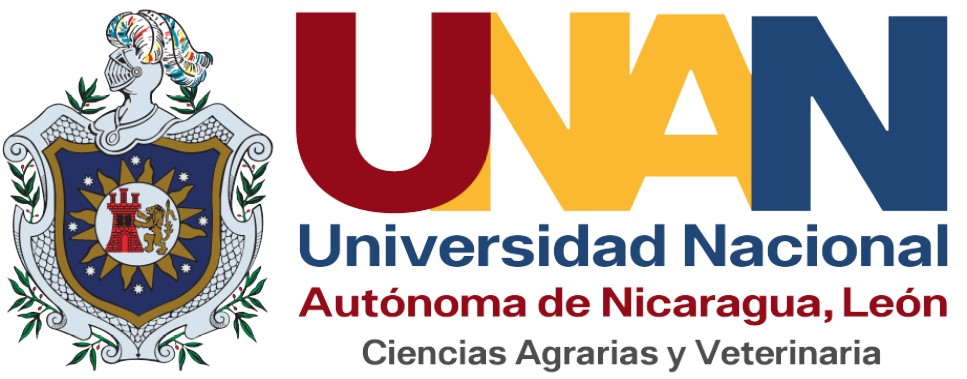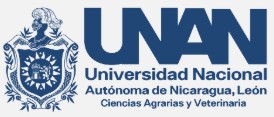Monitoring of insect pest populations in Persian lemon due to the effect of neem Azadirachta indica
DOI:
https://doi.org/10.5377/ribcc.v9i17.15495Keywords:
Biopesticide, repellent, vegetables extracts, eco intesification, Pezothrips kellyanusAbstract
Introduction: The Persian lemon (Citrus latifolia Tan), also known as Tahiti lemon and Persian lemon, is a crop susceptible to pests, which reduce the production and quality of the fruits. The goal was to evaluate different doses of the neem in the population density of pest insects and their biological effectiveness in a Persian lemon tree. Materials and methods: The experiment was carried out at the Instituto Tecnologico Superior de Jesus Carranza in a plot with 20 juvenile Persian lemon trees, the doses of the neem biopesticide treatments applied were 2, 3 and 4 ml/L every eight days during period from August to November, the insecticide cypermethrin (2 ml/L) was used as a control; the variables evaluated were: determination of the percentage of effectiveness of the biopesticide, number of pest insects, and taxonomic identification of pest insects at the tree level. Results and discussion: the insecticidal activity was observed in dose of 3ml/L (T4) and 4 ml/L (T5), which showed a reduction of thrips (Pezothrips kellyanus) and whitefly (Dialeurodes citri) population. The biopesticide used showed an effectiveness of 46% in the control of insect pest. Conclusion: The neem-based biopesticide is an alternative for the agroecological management of pest in Persian lemon crops in higher concentrations, also allows the presence of beneficial insects in the tree canopy.
Downloads
Metrics
References
Almaguer, V. G., Espinoza, E. J. R., Quirós, G. J. L., (2011). Desfasamiento de cosecha de limón Persa. Revista chapingo, serie hortícola, 17(3), 197-205.
Arias, D., Vázquez, G., Montañez, L., Álvarez, R., Pérez, V., (2009). Determinación del Azadirachta indica). Revista ingeniería UC, 16(3), 22-26.
Arias, F., Suarez, E., (2016). Comportamiento de las exportaciones de limón persa (Citrus latifolia Tanaka) al mercado de los Estados Unidos. Journal of Agriculture and Animal Sciences, 5(2), 22-33.
Artola, D. A. J., Duarte, H. M. A., Raudez, C. D., Estrada, S. D. C., (2020). Efecto de bioinsumos en la dinámica poblacional de Bemicia tabaci (GEN) Liriomyza spp.en el cultivo de tomate (Solanum lycopersicum L.)San Isidro 2017-2018. Revista Iberoamericana De Bioeconomia Y Cambio Climático, 6(12), 1456–1480. https://doi.org/10.5377/ribcc.v6i12.9932
Brotodjojo, R. R., Arbiwati, D. (2016). Effect of application of granular organic fertilizer enriched with boiler ash and neem leaves powder on plant resistance against insect pests. Int. J. Biosci. Biochem. Bioinformatics, 6, 152. DOI 10.17706/ijbbb.2016.6.4.152-157.
Cloyd, R. A., Galle, C. L., Keith, S. R., Kalscheur, N. A., Kemp, K. E. (2009). Effect of commercially available plant-derived essential oil products on arthropod pests. Journal of Economic Entomology, 102(4), 1567-1579.
Cruz, F. M y del Ángel, S. R. (2004). El Árbol de Nim, Establecimiento y Aprovechamiento en la Huasteca Potosina. INIFAP-CIRNE. Campo Experimental Huichihuayán y Campo Experimental Ébano. Folleto Técnico Núm. 3. San Luis Potosí, México. 23 p.
Cruz, F. M., (1998). Dinámica de la azadiractina en árboles de nim (Azadirachta indica A. Juss) de México y su efecto contra dos insectos de almacén. Tesis de Doctorado. UANL. Facultada de Agronomía. 73 p.
Esparza-Díaz, G., López-Collado, J., Villanueva-Jiménez, J. A., Osorio-Acosta, F., Otero-Colina, G., Camacho-Díaz, E. (2010). Concentración de Azadiractina, efectividad insecticida y fitotoxicidad de cuatro extractos de Azadirachta indica A. JUSS. Agrociencia 44, 821-833.
González, M. M. B., García G. C., (2012). Uso de biorracionales para el control de plagas de hortalizas en el norte de Sinaloa. Ra Ximhai, 8(3), 31-45.
González, M. Ma. B., Gurrola R. J. N., Chaírez H. I., (2015). Productos biológicos para el control de Spodoptera frugiperda (Lepidoptera: Noctuidae). Revista Colombiana de Entomología, 41 (2), 200-204.
Guerra, M. G., (2020). El aceite de Neem (Azadirachta indica A. Juss) una alternativa a los insecticidas químicos. Hombre Ciencia y Tecnología, 25(1), 122-128.
Gutiérrez-García, S. del C., Sánchez-Escudero, J., Pérez-Domínguez, J. F., Carballo-Carballo, A., Bergvinson, D., Aguilera-Peña, M. M. (2010). Efecto del nim en el daño ocasionado por el gusano cogollero Spodoptera frugiperda (Smith) (Lepidoptera: Noctuidae) en tres variables agronómicas de maíz resistente y susceptible. Acta zoológica mexicana, 26(1), 1-16. http://www.scielo.org.mx/scielo.php?script=sci_arttext&pid=S006517372010000100001&lng=es&tlng=es.
INFOAGRO, 2007. Programa Nacional de Agricultura Orgánica de Costa Rica. Disponible en: http://www.infoagro.com
Isman, M. B., 2006. Botanical insecticides, deterrents, and repellents in modern agriculture and an increasingly regulated world. Annu. Rev. Entomol. 51, 45–66. DOI: 10.1146/annurev.ento.51.110104.151146.
Jennifer, M. L. A., Simmonds, M. S., Ley, S. V., Blaney, W. M., Mordue, W., Nasiruddin, M., et al., (1998). Actions of azadirachtin, a plant allelochemical, against insects. Pestic. Sci. 54, 277–284. DOI: 10.1002/(SICI)1096-9063(1998110)54:3<277::AID-PS801>3.0.CO;2-I
Jothi, B. D., Verghese, A., Tandon, P. L., (1990). Evaluation of different plant oils and extracts against citrus aphid, Toxoptera citricidus (Kirkaldy). Indian journal of plant protection, 18(2), 251-254.
Kilani, M. S., Morakchi, G. H., Sifi, K. (2021). Azadirachtin based insecticide: overview, risk assessments, and future directions. Frontiers in agronomy. 3. DOI=10.3389/fagro.2021.676208.
Loera, A. E., Rodríguez, P.Y., Sánchez, V. M., Loera A. Ma. E., Pinto, V. M., Luna, C. A., (2018). Insecticidas de diferente grupo toxicológico avaluados para el control de trips en gladiola (Gladiolus glandiflorus Hort.) en campo. Tropical and subtropical agroecosystems, 21, 539-546.
López, D. M. T. y Estrada, O. J., (2005). Los bioinsecticidas de nim en el control de plagas de insectos en cultivos económicos. La habana (Cuba). Revista de la Facultad de Ciencias Agrarias. 37(2), 41-50. http://www.redalyc.org/articulo.oa?id=382838551004.
López, H. W. A., Garza, B. L. E., Cruz, G. B., Nieto, A. R., (2020). Competitividad del limón persa en la región del Papaloapan, Oaxaca. Revista mexicana de ciencias agrícolas, 10 (4), 921-934.
Marinero, O. E. A., Vargas, C. J. I., Martíne, C. G., Martínez, L., Sardinas, G. O. F., Zuñiga, G. C. A., (2014). Análisis de la agenda pública y privada de la bioeconomía en Centroamérica y el Caribe: Estudio de caso de El Salvador, Honduras, Cuba and Nicaragua. Revista Iberoamericana de bioeconomía y Cambio Climático, 1(1), 242-270. Doi:https://doi.org/10.5377/ribcc.vlil.2151.
Megchun, G. J. V., Castañeda, C. M. del R., Rodríguez, L. D. A., Adame, G. J., Murguía, G. J., Lango, R. F., Leyva, O. O. R., (2018). Use of thiamethoxam, associated with insect populations in papaya (Carica papaya Linnaeus) cultivation. International Journal of Research - Granthaalayah, 6(1), 428-439. https://doi.org/10.5281/zenodo.1168978.
Megchun, G. J. V., Castañeda, C. Ma. Del R., Del Ángel, P. A. L., Constantino, L. G. G., Nataren, V. J., Zaragoza, V. E., (2023). Synthetic fertilizers and vermicompost in juvenile persian lime (Citrus X latifolia Tanaka ex Q. Jimenez) trees. Agroproductividad, 16(2), 65-74. https://doi.org/10.32854/agrop.v16i2.2384
Megchun, G. J. V., Castañeda, C. Ma. del R., Rodríguez, L. D. A., Murguía, G. J., Lango, R. F., Leyva O. O. R., (2019). Impact of thiamethoxam in papaya (Carica papaya Linnaeus) in rotation with watermelon (Citrullus lanatus) crops. Agriculture, 9 (129). doi:10.3390/agriculture9060129
Miranda-Ramírez, J. M.., Perales-Segovia, C., Miranda-Salcedo, M. A., & Miranda-Medina, D. (2021). Insecticidas de bajo impacto ambiental para el control de Diaphorina citri Kuwayama, 1908 (Hemiptera: Liviidae) en limón mexicano (Citrus aurantifolia (Christm.) Swingle). Revista chilena de entomología, 47(4), 723-732. https://dx.doi.org/10.35249/rche.47.4.21.09
Morales I. D., 2013. swfrec. Obtenido de swfrec: https://swfrec.ifas.ufl.edu/hlb/database/pdf/22_DeSantos_13.pdf.
Muñis, R. E., Ramos, B. C. A., Rodríguez, H. C., Ortega, A. L. D., (2016). Actividad biológica de nim en adultos de mosca blanca Trialeurodes vaporariorum (Aleyrodidae) West. Revista mexicana de ciencias agrícolas. 7(6):1283-1295.
Murillo, C. F. D., Cabrera, M. H., Adame, G. J., Fernández, V. J. A., Villegas, N. J., López, M. V., Vázquez, H. A., Meneses, M. I., (2020). Evaluación de insecticidas biorracionales en el control de mosca blanca (Hemiptera:Aleyrodidae) en la producción de hortalizas. Biotecnia 22(1): 39-47.
Rebolledo, M. L., Megchún, G. J. V., Rebolledo, M. A., Orozco, C. D. M. (2019). Asociación de frutales de limón Persa (Citrus latifolia) y palma de coco (Cocos nucifera L.) con el aporte de materia seca por cultivos anuales. Revista Iberoamericana de Bioeconomía y Cambio Climático, Vol. 5(10), 2410-7980.
Ruíz-Jiménez, K. Z., Osorio-Osorio, R., Hernández–Hernández, L. U., Ochoa-Flores, A. A., Silva-Vázquez, R., Méndez-Zamora, G. (2021). Actividad acaricida de extractos vegetales sobre el ácaro rojo de las palmas Raoiella indica (Acar: Tenuipalpidae). Revista de la Sociedad Entomológica Argentina, vol. 80 (1).
Sánchez, B. Ma. G., Escobar, S. L., Zavala, H. F., Carachure, O. P., Ascencio, A. L. de J., Álvarez, D. G., (2023). Insectos depredadores asociados en cultivos de limón (Citrus limon), como agente de control biológico. Ciencia latina revista multidisciplinar, 7(1), 9887-9904.
Sánchez, T. Y., Matus, G. J. A., García, S. J. A., Martínez, D. M. A., (2011). Estimación de la demanda de importaciones de limón persa (Citrus latifolia Tanaka) en Estados Unidos procedentes de México (1994-2008). Tropical and subtropical agroecosystems, 14(3), 819-827.
Santistevan, M. M., Helfgott, L. S., Loli, F. O., Julca, O. A., (2016). Comportamiento del cultivo del limón (Citrus aurantifolia swingle) en dos localidades de Santa Elena, Ecuador. Revista científica y tecnológica UPSE, 3(2), 15-20.
SIAP, (2017). Limón: casi 2.44 millones de toneladas en 2016. http://infosiap.siap.gob.mx:8080-agricola_siap_gob_mx_ResumenProducto.do
Sirohi, A., Tandon, P. (2014). Insecticidal effects of various parts of Azadirachta indica on adults of Aulacophora foveicollis (Lucas) (Coleoptera: Chrysomelidae). T rends Biosci. 7, 3947–3949.
Sonorza, R. D., Zambrano, G. F. E., Moreira, S. J. R., Zambrano, D. J. F., Armiñana, G. R., Fimia, D. R., (2020). Percepción de los agricultores sobre la eficacia de parasitoides en el control de plagas y en la sostenibilidad agroecológica del limonero, Riochico, Portoviejo, Ecuador. Neotropical Helminthology, 14(1), 75-84.
Tang, Y. Q., Weathersbee, A. A., Mayer, R. T., (2002). Effect of Neem Seed Extract on the Brown Citrus Aphid (Homoptera: Aphididae) and its Parasitoid Lysiphlebus testaceipes (Hymenoptera: Aphidiidae), Environmental Entomology, 31(1), 172–176. https://doi.org/10.1603/0046-225X-31.1.172.
Úbela, R. J. S., Delgado, D. Y., (2018). La infiltración del agua en los suelos y componentes artificiales y materia orgánica que se utilizan en ellos para la agricultura. Revista Iberoamericana de Bioeconomía y Cambio Climático, 4(7), 889-894. DOI:https://doi.org/10.5377/ribcc.v4i7.6299
Valle-Pinheiro, P., Dias-Quintela, E., Pereira de Oliveira, J., Seraphin, J. C. (2009). Toxicity of neem oil to Bemisia tabaci biotype B nymphs reared on dry bean. Entomology –Pesq agropec. Bras 44 (4). https://doi.org/10.1590/S0100-204X2009000400004.
Downloads
Published
How to Cite
License
Copyright (c) 2023 Rev. iberoam. bioecon. cambio clim.

This work is licensed under a Creative Commons Attribution-NonCommercial-ShareAlike 4.0 International License.
Copyright © 2025 Rev. iberoam. bioecon. climate change. National Autonomous University of Nicaragua León (UNAN-León), Knowledge Area of Agrarian and Veterinary Sciences / Specific Area of Agroecology and Agribusiness / Center for Research in Agrarian Sciencies. Academic Directorate. Research Department. Publication and scientific events Unit.












 EDITORIAL
EDITORIAL e-ISSN
e-ISSN


 COPYRIGHT
COPYRIGHT This work is licensed under a Licencia Internacional
This work is licensed under a Licencia Internacional 












